Fluxton & Ottery St Mary STWs (2017)
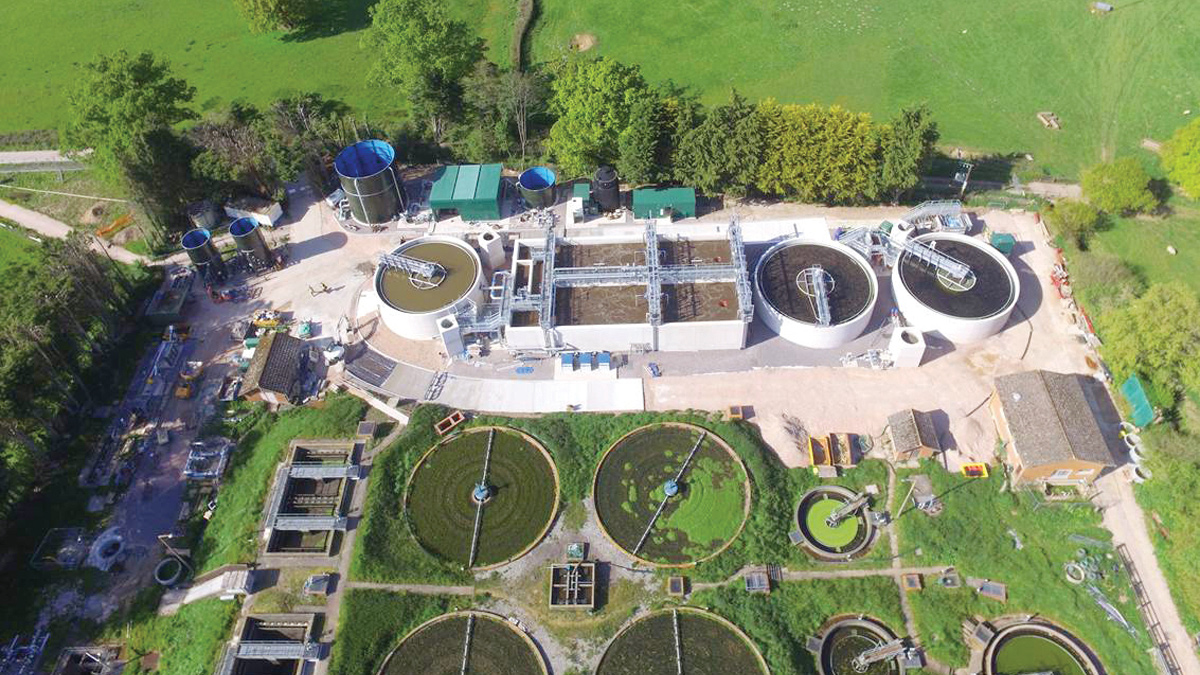
Aerial view of new works - Courtesy of South West Water Delivery Alliance H5O
Fluxton and Ottery St Mary STWs are located in the Otter Valley, East Devon. The town of Ottery St Mary has a population of 4898 and is situated on the River Otter, approximately 10 miles east of Exeter, and the nearby hamlet of Fluxton has a population of approximately 99. The Fluxton site itself is located within a very small plot within the floodplain adjacent to the River Otter and an upgrade was required to provide sufficient capacity for population growth in the Ottery area and achieve a future Total P permit.
Background
Under this project, 100% of pass forward flow will be transferred to Fluxton by the existing Ottery SPS (located within Ottery St Mary STW site boundary), leaving just the storm tanks operational as a combined sewer overflow. A whole new process stream will be constructed at Fluxton to ensure there is sufficient capacity to a 2031 design horizon.
The upgraded treatment facilities at Fluxton will provide additional process capacity to meet the 2031 design horizon, the increase in catchment growth and the anticipated EA discharge permit of 39mg/l biochemical oxygen demand (BOD), 60mg/l total suspended solids (TSS) and 13mg/l ammonia (NH4-N). The Fluxton works upgrade will ensure that the works not only meets the required treatment level but also overall operability will be improved by reducing the operational requirements at Ottery St. Mary.
Impact of total phosphorus permit
During the Asset Management Programme review it was envisaged that the Environment Agency would apply a total phosphorus permit at the Fluxton STW at levels between 1-2mg/l, based on permitting standards for Fluxton and Ottery St Mary STWs. However, having secured the budget approval for the capital maintenance (CM) and supply and demand (S&D) projects the EA’s National Environmental Programme was revised and in doing so identified a further requirement for a total phosphorus (Total P) discharge permit of <0.63mg/l to be applied from the 31 March 2020.
This level was based on the EA’s final modelling analysis of the impacts of the discharge to the River Otter, taking in to account all other sources within the catchment area.
The project would also contribute towards the ‘River Water Quality Improved’ outcome delivery incentives by improving the water quality of the 49km stretch of water body that Fluxton STW discharges to, which in turn influences the tidal limit of the watercourse.
The initial secondary process solution was to upgrade the works with plastic media filters, this being the optimal process solution to make provision for the Total P requirement of between 1-2mg/l. However, due to the newly revised tighter Total P permit requirements a greater compliance risk was associated with the use of the plastic filter media solution.
The increased risk was due to the lower level of effluent solids required to comply with the tighter Total P standards. A process review was undertaken to establish the optimum holistic solution in meeting both CM and S&D and the new Total P requirements.
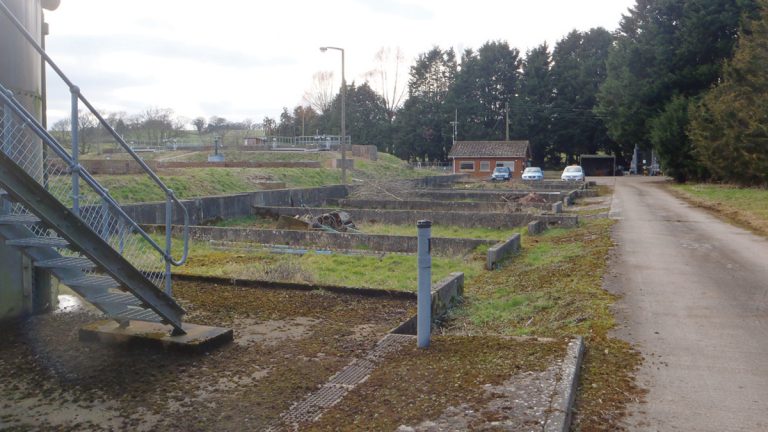
Existing sludge beds – Courtesy of South West Water Delivery Alliance H5O
Summary of options
The process review considered two potential solutions:
- Approved plastic media solution.
- Activated sludge plant (ASP).
When considered holistically the ASP process was more cost effective as solids are removed more efficiently reducing the number of tertiary filters and associated equipment required to achieve the tight Total P requirement.
The process review concluded that the ASP rather than the plastic media filters for the secondary process for the CM and S&D was the optimal overall process, and the most cost effective. Due to a number of complicated interfaces it was deemed acceptable in meeting both CM, S&D and Total P projects would benefit by concurrent design and construction.
A number of options were reviewed which considered the differences associated with the introduction of the tighter Total P requirement. These were:
- Activated sludge plant and Total P removal: This would require the addition of two point Claral dosing, a return liquor balancing tank, increased sludge treatment process capacity and a single tertiary solids filter.
- Plastic media filters and Total P removal: This would also require the same scope as for the ASP. However due to the higher levels of suspended solids in the effluent produced from the plastic media filters, a two stage tertiary solids removal process would be required. In addition, as the tertiary treatment process generates more return liquors, a larger primary settlement tank would be required.
Preferred option solution
From a process point and due to the increased permitting requirements in regards to Total P the ASP solution for the CM and S&D would provide not only a more robust and reliable process solution but also reduce the operational risks.
Due to the numerous and complicated interfaces and the inclusion of the tighter Total P permitting restrictions due to come into effect, it was decided that the design and construction would be achieved concurrently with that of the CM and S&D, combining all three outputs for delivery.
Efficiency
The holistic review of the overall solution had identified that the most cost effective and least risk delivery solution would be to design and construct the Total P project concurrently with the CM and S&D projects.
There were no changes to the capital efficiencies previously calculated (plastic filter media option) due to the proposed project change.
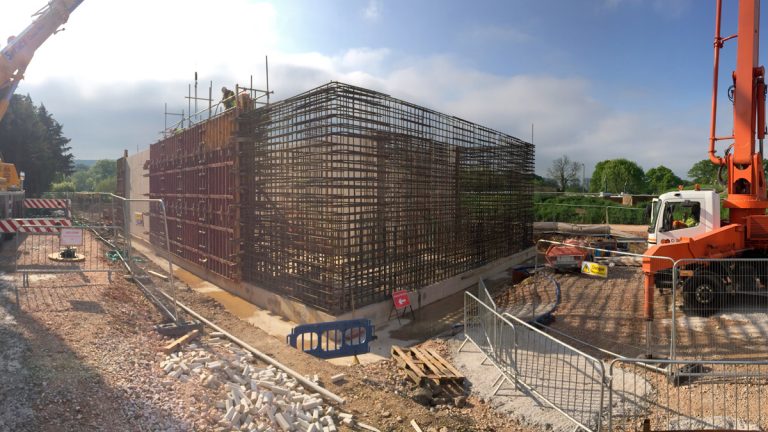
Rebar construction – Courtesy of South West Water Delivery Alliance H5O
The scope of the works: Ottery STW
Works at Ottery included the Installation of a new overflow chamber adjacent to storm tank. The existing (new) storm screen was to be re-located upstream of storm tank, with a continuation flow being limited to 28l/s (existing FFT permit). In addition:
- Utilising actuated penstock plus magflow meter, or similar.
- Divert low level sewer SPS via new overflow chamber.
- Decommission and make safe existing STW process, including electrical isolation and removal of chemicals.
The following fall into the decommissioning scope of works at Ottery STW:
- Inlet channel: drain down and backfill channel with suitable material. Electrically isolate macerators and remove.
- Place equipment to one side for removal/reuse by SWW.
- Drain down and clean PST tanks, core holes in tank walls to allow drainage of rainwater. Backfill with suitable material.
- Remove metalwork to humus tanks and dispose off site.
- Sludge storage covers to be secured.
- Electrically isolate the lower control building from main control building and ensure covers are secured.
- MCERTS flowmeter at OSM outfall to be electrically isolated at control building.
- Impeller change to existing pumps.
The scope of the works: Fluxton STW
Additional process capacity at Fluxton STW to meet expected population growth to 2031 design horizon and to comply with the new 0.63mg/l Total P permit required by 31 March 2020. Works required the inclusion of:
Inlet Works
- New Huber Technology standby screen to be capable of passing 109 l/s required for compliance with technical standards.
- Extension of existing inlet screen channel required to accommodate new bypass channel with hand raked screen to suit.
- M&E refurbishment of existing Jeta grit trap including new grit classifier.
- Upgrade of inlet PS to 60 l/s FFT.
Primary and Secondary Treatment
- 1 (No.) 12.5m diameter primary settlement tank.
- 3 (No.) compartment selector and 1 (No.) ASP provided in two 50% streams.
- 2 (No.) 14m diameter FSTs, including RAS/SAS pumping station.
Fluxton STW Sludge
- New unthickened (raw) sludge tank to provide two days raw sludge holding.
- New sludge thickener package 25m3/hr raw sludge capacity.
- Conversion of existing sludge tanks to thickened sludge holding tanks to provide five days thickened sludge storage capacity.
In addition, the decommissioning scope of works of existing assets at Fluxton included the following:
- Screw pump inlet channel
- Electrically isolate the screw pump inlet channel and backfill sump.
- PSTs
- Drain down and clean. Leave desludge valves open to allow drainage of surplus rainwater.
- Remove scumboards, diffusers etc and mechanical equipment. Backfill tank to coping with suitable granular material.
- Humus tanks
- Electrically isolate, remove and dispose of scraper bridges. Core drainage holes in tank walls (assume 2 (No.) 150mm diameter holes per tank) and backfill with suitable material.
- Backfill exposed sludge sump with suitable granular material.
Proposal
Flows arriving at Fluxton STW will be screened to 6 mm 2D at the works inlet, prior to flow control. A new standby screen is being installed to improve process robustness.
The flow to full treatment of the new works had been based on the calculated 3DWF of 60l/s. As per the existing permit, flows above 3DWF (FFT) will be diverted to the storm tanks. The revised 3DWF has been calculated as 60l/s and the overflows will be adjusted to suit this revised flow rate.
The required storm storage volume had been calculated as 194.4m3 based on providing 2 hour retention at peak flow to storm tanks. The storm storage tanks at Fluxton provide 418m3 of storage and was therefore sufficient.
Construction
With the existing site continuing to operate during the new construction phase it was important to maintain a small footprint in line with the planning application process. The existing sludge beds were to be broken up and material removed from site.
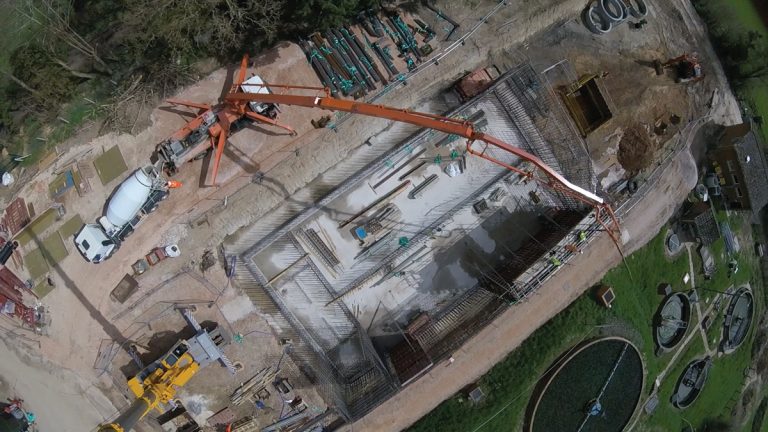
Base and wall construction – Courtesy of South West Water Delivery Alliance H5O
The removal of material from site would have been extremely difficult due to restricted routes and site manoeuvrability, increasing time and cost on site. During the construction development phase the Balfour Beatty site team proposed the reuse of this material, mainly concrete, and they were subsequently able to reuse up to 90% as base material for the formation of the new PST, FSTs and ASP bases.
The scheme not only included the added phosphorus removal but included the decommissioning of Ottery St Mary STW and so the flows generated at Ottery would directly impact Fluxton STW.
Careful planning on how both sites interconnected was vital to the programme due to a lengthy commissioning period. A number of sub-contractor interface programmes hinged on the civil works through direct labour, and failure to meet construction deadlines would have a detrimental effect on the ability of the sub-contractor to meet deadlines. Procurement, construction, M&E interface, and commissioning would all be affected if one deadline was delayed.
This was a very definitive constraint that allowed for no flexibility in the program. This included the need to incorporate a new grit plant on to the program that would allow for up to 90% of the arisings from the existing sludge beds to be reconstituted and reused for the bases for the concrete structures. With this change the site team was able to reduce not only the frequency and size of traffic around site, but also the local transport routes to and from the works. This had a major effect on the local population, as the site is located deep in agricultural territory.
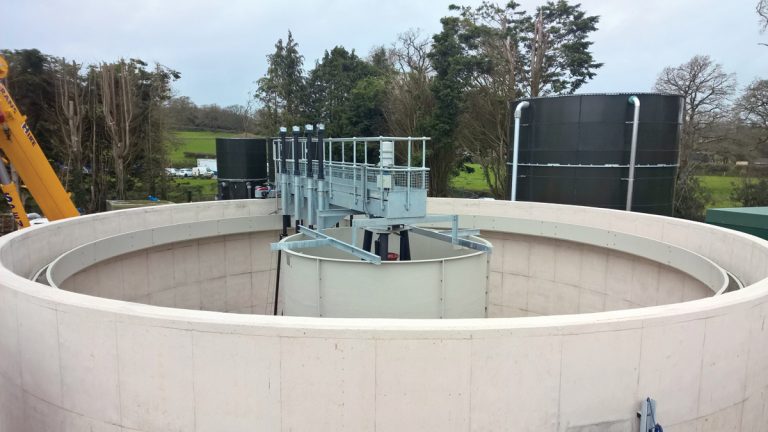
Steel fabrication – Courtesy of South West Water Delivery Alliance H5O
Setting project milestones
Due to the complex nature of the scheme and with subcontractor involvement key, it was vital that a detailed programme was developed which clearly set milestones within the project. For the norm this program was essentially managed by the site team. However, due to the nature of this work and a very constrained period in which to deliver, it was agreed that a number of meetings and approval processes would have to be met prior to the next stage of the program commencing. This would include approval from all parties and included milestones such as outline and detailed design stages, pre-construction phase plan, health and safety checks, procurement schedules, weekly site meetings, strategic monthly progress meetings, monthly commercial meetings, and design review meetings.
It was also decided that for ‘critical works’ a full desk top review and site meeting would take place to ensure all aspects of the works and risk would be captured, and included mitigation and contingency planning. Finally, post project evaluation and lessons learnt are programmed in on completion of the project to ensure good and bad points from the project are passed on.
Conclusion
In order to reduce the risk from flooding and to aid future programmed operating and maintenance the site team led by Robin Goodman worked tirelessly with the design consultants Pell Frischmann through design manager Leo Wardell to ensure that were practical, pipework, pump stations, and storage containment, were calculated, designed, and positioned away from the threat to flooding.






